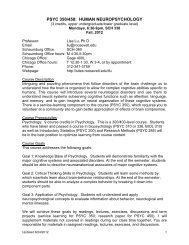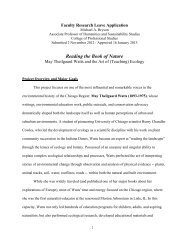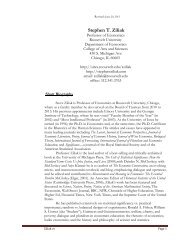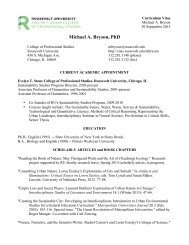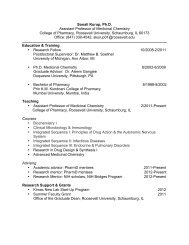Social Insurance and Public Assistance
public-assistance-welfare-reform-colonial-times-to-the-present-ziliak ...
public-assistance-welfare-reform-colonial-times-to-the-present-ziliak ...
Create successful ePaper yourself
Turn your PDF publications into a flip-book with our unique Google optimized e-Paper software.
SOCIAL WELFARE PROGRAMS Series Bf377–394 765<br />
TABLE Bf377–394 Old-Age, Survivors, Disability, <strong>and</strong> Health <strong>Insurance</strong> – covered workers, earnings, employers,<br />
<strong>and</strong> tax rates: 1937–1999 Continued<br />
doctors of medicine were covered, <strong>and</strong> in 1967 the previous elective coverage<br />
of ministers became compulsory unless exemption was claimed on grounds<br />
of conscience or religious principle.<br />
When the OASDHI program began in 1937, fewer than 60 percent of<br />
all persons who worked in paid employment during an average week were<br />
covered. Following the 1950 amendments, the proportion rose to 75 percent<br />
<strong>and</strong> by 1970 was more than 90 percent. In the mid-1990s about 96 percent<br />
of all jobs in the United States were covered. Workers excluded from coverage<br />
fall into five major categories: (1) federal civilian employees hired before<br />
January 1, 1984, (2) railroad workers, (3) certain employees of state <strong>and</strong> local<br />
governments who are covered under a retirement system, (4) household<br />
workers <strong>and</strong> farm workers whose earnings do not meet certain minimum requirements,<br />
<strong>and</strong> (5) persons with very low net earnings from self-employment<br />
(generally less than $400 annually). Federal civil servants hired prior to 1984<br />
<strong>and</strong> railroad employees are covered, separately, by compulsory, contributory<br />
retirement systems of their own. The railroad system is closely coordinated<br />
with OASDHI.<br />
To qualify for cash benefits, a worker must have worked a sufficient time<br />
in covered employment to have acquired an insured status (see series Bf377–<br />
379). Workers are considered “fully insured” when they meet the minimum<br />
requirements for insurance; they become “permanently insured” when they<br />
become eligible for a required-worker benefit. Workers are insured in the<br />
event of disability if they are considered fully insured <strong>and</strong> have contributed<br />
a sufficient amount to receive disability insurance. Under the 1939 amendments,<br />
workers were generally “fully insured” for benefits if they had worked<br />
in covered employment half the time after 1936 <strong>and</strong> before age 65 <strong>and</strong> had<br />
a minimum of six calendar quarters of coverage. Subsequent liberalizations<br />
permitted a person to become fully insured if he had been in covered work<br />
roughly equal to one fourth of the time between 1950 (or age 21, if later)<br />
<strong>and</strong> retirement age or death. Based on the rules in 1970, if a worker died<br />
before acquiring a fully insured status but was “currently insured” 1.5 years<br />
of employment out of the 3 preceding years, death-survivor benefits may be<br />
paid to his young widow with children. To be insured for disability benefits,<br />
circa 1970, a worker must generally have worked for at least five out of the<br />
ten years before onset of disability. The 1965 amendments eased the eligibility<br />
requirements for persons 72 years old <strong>and</strong> older who were not eligible<br />
for cash benefits by introducing a transitional insured status under which a<br />
special flat monthly benefit may be paid to persons with three to five quarters<br />
of coverage. A 1966 amendment extended these special monthly benefits to<br />
certain persons 72 years old <strong>and</strong> older who could not meet even these minimal<br />
requirements. Lump-sum payments became payable in 1937; monthly<br />
benefits, in 1940. The original <strong>Social</strong> Security Act provided for monthly oldage<br />
benefits only. Amendments adopted in 1939 added benefits for dependents<br />
<strong>and</strong> survivors of the insured worker. Benefits for disabled persons were<br />
added in 1956, <strong>and</strong> benefits for the dependents of disabled persons, in 1958.<br />
Beginning in 1966, the cost of rehabilitation services furnished to disability<br />
beneficiaries was also paid by the program. A complete discussion of insured<br />
status can be found in the <strong>Social</strong> Security Bulletin: Annual Statistical Supplement,<br />
1997, p. 372.<br />
Since 1940, the OASDHI program has been a pay-as-you-go system<br />
funded by taxes on earnings for wage <strong>and</strong> salary workers <strong>and</strong> the selfemployed.<br />
An employer deducts <strong>Social</strong> Security contributions from a worker’s<br />
pay <strong>and</strong> adds an equal amount for his tax as employer. The money is forwarded<br />
to the Internal Revenue Service <strong>and</strong> deposited into federal trust funds<br />
from which the benefits <strong>and</strong> administrative expenses are paid. Self-employed<br />
persons pay their <strong>Social</strong> Security contributions with their federal income<br />
tax. For example, the information in series Bf386–394 shows that in 1990<br />
a typical worker would pay a tax on earnings up to a maximum of $51,300<br />
of 5.6 percent for Old-Age, Survivors <strong>Insurance</strong> (OASI), start 0.6 percent<br />
for Disability <strong>Insurance</strong> (DI), <strong>and</strong> 1.4 percent for Medicare. The employer<br />
would pay the matching amount. The self-employed would pay both the<br />
worker <strong>and</strong> employer share, or 11.2 percent for OASI, 1.2 percent for DI, <strong>and</strong><br />
2.8 percent for Medicare. The Omnibus Budget Reconciliation Act of 1993<br />
repealed the Medicare maximum so that now all earnings are subject to the<br />
Medicare tax. In 1984 the total contribution rate for OASDHI for employers<br />
<strong>and</strong> employees each (the sum of series Bf389–391) includes an automatic tax<br />
credit of 0.3 percent for remuneration paid in the calendar year 1984 under<br />
the Federal <strong>Insurance</strong> Contributions Act. During the period 1984 to 1989,<br />
the total contribution rate for OASDHI for self-employed (the sum of series<br />
Bf392–394) includes an automatic tax credit of 2.7 percent of earnings for<br />
self-employed income for taxable years beginning in 1984, 2.3 percent for<br />
taxable years beginning in 1985, <strong>and</strong> 2.0 percent for taxable years beginning<br />
in 1986, 1987, 1988, <strong>and</strong> 1989. During this period, scheduled taxes were<br />
credited to the <strong>Social</strong> Security Trust funds, monies for tax credits were paid<br />
from the Treasury, <strong>and</strong> the reduced tax rates were paid by employees <strong>and</strong> the<br />
self-employed. For more information, see <strong>Social</strong> Security Bulletin, Annual Statistical<br />
Supplement, 1997,Table 2.A4, p. 35. Unlike the income tax, the OASDHI<br />
taxes are drawn on the first dollar of earnings; however, the working poor receive<br />
some relief from the OASDHI payroll taxes through the earned income<br />
tax credit.<br />
Series Bf380. The estimated total number of living workers is the estimated<br />
number of persons who had covered employment any time during the period<br />
from 1937 to the year shown. It is not adjusted to reflect the effect of<br />
provisions that coordinate the OASDHI <strong>and</strong> Railroad Retirement programs<br />
<strong>and</strong> wage credits for military service. It is only partially adjusted to eliminate<br />
duplicate counts of persons with taxable earnings reported on more than<br />
one <strong>Social</strong> Security number.<br />
Series Bf381–385. Relate only to wage <strong>and</strong> salary workers for the period<br />
1937–1950. Beginning in 1951, the data include self-employed workers <strong>and</strong><br />
earnings.<br />
Series Bf383. New entrants into covered employment are workers reported<br />
with first taxable earnings under the program in a specified year. During<br />
the period 1937–1994, 276.2 million different persons were reported with<br />
taxable earnings.<br />
Series Bf382–383 <strong>and</strong> Bf385. Preliminary estimates are based on data from<br />
the Bureau of Labor Statistics <strong>and</strong> the National Income <strong>and</strong> Product Accounts.<br />
Series Bf381–383, Bf385, <strong>and</strong> Bf387. Data for 1996 are preliminary estimates<br />
based on data from the Bureau of Labor Statistics <strong>and</strong> the National<br />
Income <strong>and</strong> Product Accounts.<br />
Series Bf386–387. Data for 1975–1978, 1982–1989, <strong>and</strong> 1993–1996 are<br />
based on automatic adjustment under 1972a Act (as modified by 1973a<br />
<strong>and</strong> 1973b Acts), in proportion to increases in the average wage level. The<br />
maximum earnings taxable for HI in 1991 is based on 1990 legislation.<br />
Series Bf388. No longer reported in statistical supplement after 1977.



